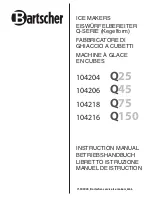
Spark Plugs
Chapter 2 Spark Plugs
32
[Appearance] The insulator section and
electrode section is black and lustrous
with wet oily deposits.
[Results] Poor starting and misfiring.
[Cause] Oil leaking due to piston ring,
cylinder, or valve guide wear (occurs
easily to new engines and engines that
have just been overhauled), high oil
content in air-fuel mixture (2-stroke
engines).
Oil fouling
2
[Appearance] The spark plug is wet with
gasoline immediately after it is removed,
but it soon dries off.
[Results] Poor starting and misfiring.
[Cause] The air-fuel ratio is too rich and
is not igniting. (Among the ways this can
happen is if the driver presses the
accelerator over and over while starting
the vehicle.)
[Handling] Remove all the spark plugs,
crank the starter motor to bring fresh air
into the cylinder and make the air-fuel
ratio leaner.
Fuel fouling
3
[Appearance] The center and ground.
electrodes are rounded and the gap has
become too wide.
[Result] Poor starting and acceleration.
[Cause] Inadequate maintenance (spark
plug has exceeded its service life).
Extreme electrode wear
4
[Appearance] The gap is wider than
appropriate.
[Result] Poor starting and acceleration.
[Cause] The gap is inappropriate; the
wrong spark plug was selected.
Spark plug gap too large
5
[Appearance] Insulator cracked.
[Result] Shorts due to insulation defect,
causes poor idling and misfiring during
acceleration.
[Cause] Spark plug removed/installed
incorrectly (spark plug turned too far
with spark plug wrench, excess
tightening torque, or other inappropriate
work).
Insulator breakage
6
[Appearance] The insulator leg section
has yellow or yellowish-brown burnt on
deposits or is covered with a glossy
surface.
[Result] Misfiring during rapid
acceleration or under high load, but no
problem in normal running.
[Cause] Use of gasoline with much lead.
●
Lead fouling
















































